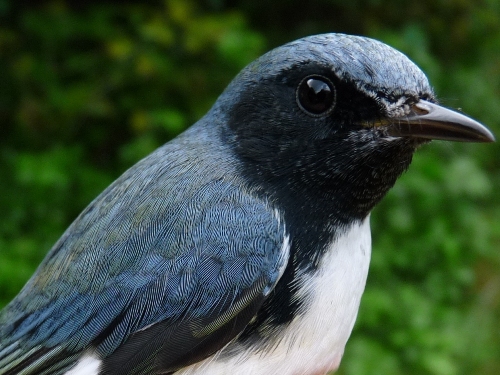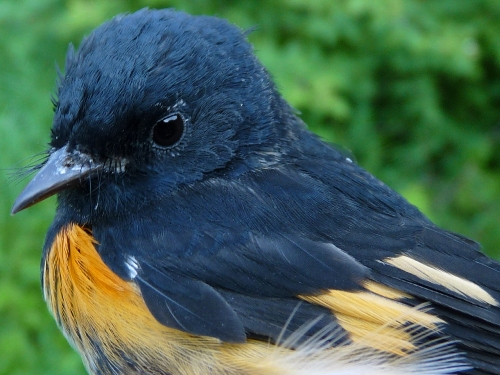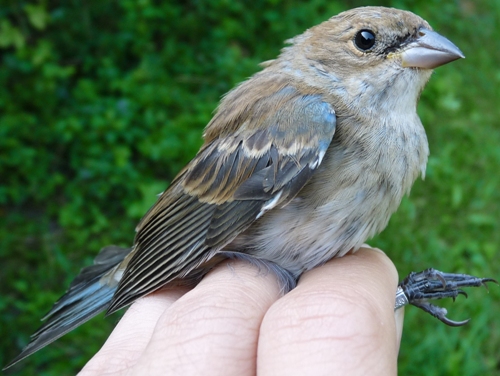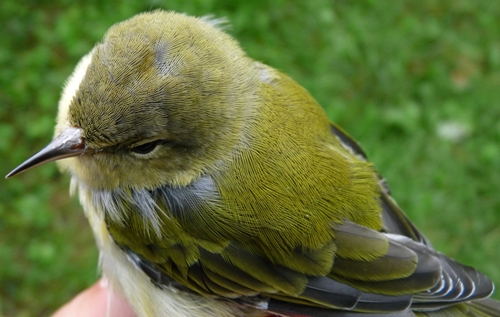|
Week 5: August 29 - September 4, 2009 |
Welcome
to the McGill Bird Observatory weekly report.
Click here for a complete listing of our archives.
Comments or
questions are welcome at "mbo AT migrationresearch.org".
|
PICTURE
OF THE WEEK: |
|

Among the warblers regularly seen at MBO, the Black-throated Blue has one of the
most protracted migrations, often present from early August through to mid-October,
but rarely in large numbers. So, we were pleasantly surprised to have them tied for
the fourth-most frequently banded species this week, with 8 individuals in total.
(Photo by Marcel Gahbauer)

|
MBO
gratefully acknowledges the financial support
provided for the 2009 Fall Migration Monitoring
Program by TD Friends of the Environment Foundation
|
|
|
|
THIS WEEK |
THIS FALL |
2009 TOTAL |
SITE TOTAL |
|
# birds (and species) banded |
159 (34) |
915 (56) |
1919 (77) |
20840 (105) |
|
# birds (and species) repeat |
37 (11) |
179 (25) |
458 (40) |
3805 (66) |
|
# birds (and species) return |
7 (6) |
21 (15) |
139 (31) |
593 (37) |
|
# species observed |
76 |
112 |
156 |
198 |
|
# net hours |
476.3 |
2519.0 |
5877.5 |
36342.8 |
|
# birds banded / 100 net hours |
33.4 |
36.3 |
32.5 |
57.3 |
|
|
Note: table does not include nocturnal banding (owls) |
|
Banders-in-charge: Simon Duval, Marcel Gahbauer, Gay Gruner
Assistants: Christine Barrie, Sophie Cauchon, Jean Demers, Nicki Fleming, Barbara Frei, Tiffany Gilchrist, Barbara and Don MacDuff, Francine Marcoux, Chris Murphy, André Pelletier, Emilie Roy-Dufresne, Clémence Soulard, Alex Stone
Notes: The numbers for this week look decent, but that's largely to a couple of very productive days that stood in stark contrast to the rest. With respect to birds banded, 47 on Monday and 40 on Friday were both among the five busiest days so far this season ... but we lost Saturday to rain, and on the other days we had meager totals ranging from just 11 to 22. We had a similar week 5 lull in 2006 on the way to a very successful season, so hopefully this is just a temporary blip in activity. On the other hand, there have been various reports this year of an unusually poor (cold and wet) breeding season across much of northern Canada, so it's possible that a variety of species may have had relatively unsuccessful breeding seasons that would be reflected in our fall numbers. We'll have a better idea about that as the season progresses.
Despite the foregoing comments, we're so far still in good position compared to previous years with respect to most of our totals. We've banded 56 species to date (previous range 53 to 59), with this week's new additions being Bay-breasted and Blackpoll Warblers. Meanwhile, though the 76 species observed this week is a record low for week 5 (previously 79 to 88), they included four new species (Pied-billed Grebe, Peregrine Falcon, Northern Parula, and Blackpoll Warbler), bringing our season total to 111 (previous range 107 to 112).

Yes, it's yet another American Redstart photo. This, however, is a particularly interesting individual, as we banded him as an after-hatch-year male in August 2007, and this Thursday recaptured him for the first time since then.
(Photo by Marcel Gahbauer) |
After spending all of August atop our list of most frequently banded species, Song Sparrows have finally been deposed, with Magnolia Warblers taking over, largely on the strength of 16 individuals banded on Monday morning alone. Magnolia Warbler has topped the week 5 list in all previous fall seasons, so their abundance this week was no surprise. Meanwhile American Redstarts continue their strong showing this year, in second place for a third week in a row, and with a cumulative total to date of 88 individuals banded, already approaching the fall season record of 99 we set last year. Common Yellowthroat and Black-capped Chickadee slid a bit down the list this week, with Black-throated Blue Warbler jumping in at 4th place, and Yellow-bellied Flycatchers in decent numbers for a second straight week. Indigo Buntings made the list thanks to just two net rounds on Thursday morning!
This week’s top 10 [last week's rank in brackets]
# individuals banded |
mean # individuals observed daily |
1. Magnolia Warbler (31) [4] |
1. Canada Goose (24.3) [-] |
2. American Redstart (26) [2] |
2. Black-capped Chickadee (22.0) [2] |
3. Song Sparrow (10) [1] |
3. American Crow (17.7) [1] |
4. Black-throated Blue Warbler (8) [-] |
4. Cedar Waxwing (16.4) [3] |
4. Common Yellowthroat (8) [3] |
5. American Goldfinch (12.1) [4] |
6. Black-capped Chickadee (6) [4] |
6. Common Grackle (11.9) [9] |
6. Yellow-bellied Flycatcher (6) [9] |
7. American Redstart (8.1) [9] |
8. Indigo Bunting (5) [-] |
8. Blue Jay (7.6) [-] |
8. Wilson's Warbler (5) [-] |
9. Gray Catbird (7.4) [6] |
10. House Wren (4) [-]
10. Gray Catbird (4) [-]
10. Cedar Waxwing (4) [9]
10. Northern Waterthrush (4) [-]
10. Canada Warbler (4) [-]
|
10. Magnolia Warbler (6.6) [-] |
|
Flocks of Canada Geese have started to pass by on some mornings, allowing them to jump right to the top of the list of most observed species. Last week's top four shuffled slightly down as a result; of note, the chickadee count rose as high as 47 on Friday, and it's quite apparent that the vast majority of them are migrants rather than our local residents. Early indications therefore suggest that the two-year cycle of Black-capped Chickadees is progressing as expected (though in other "odd" years we didn't notice the influx distinctly until later in September). American Robin, Song Sparrow, and Red-winged Blackbird dropped off the list this week, replaced by the goose, Blue Jay, and Magnolia Warbler.
|

Thursday was a "blue" morning at MBO, during which we captured the Black-throated Blue Warbler featured at the top of this week's report, plus a Blue Jay, and five Indigo Buntings, including three side by side in one net. Hatch-year birds of this species can be tricky to sex, but ones with as much blue in the shoulder and tail as this one are very likely males.
(Photo by Marcel Gahbauer)

A greenish warbler with small flecks of orange on top of the head ... must be an Orange-crowned Warbler, right? Wrong - this is actually an after-hatch-year Tennessee Warbler! She was banded at MBO within the first few days of the current season, and recaptured this week, i.e. roughly three weeks later. Even now, she is still replacing her flight feathers (some partly grown feathers and shafts are visible in the photo) and so probably won't be leaving for a little while longer. The slightly orange-tipped feathers are a misleading anomaly, as otherwise the bird has relatively typical Tennessee Warbler features.
(Photo by Marcel Gahbauer)
|





